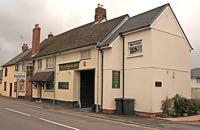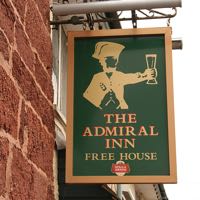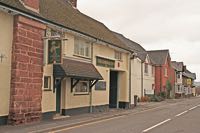
Admiral Vernon – Chudleigh Road
Page updated 11th February 2019
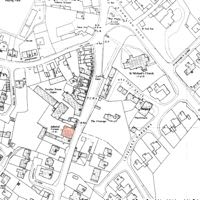 The recently closed Admiral Inn, or Admiral
Vernon building is a 15th Century cross-passage house with later alterations and with a 17th Century cob barn and early-19th Century linhay to rear.
The recently closed Admiral Inn, or Admiral
Vernon building is a 15th Century cross-passage house with later alterations and with a 17th Century cob barn and early-19th Century linhay to rear.
Sir William Courtenay (died 1511) donated a parcel of land close to Alphington Church for a Church House to be built in 1499. It was a Tudor style, thatched building to be used for parochial and manorial meetings. An inn was established that was called the Red Lion, in part of the Church House. The income from leasing the land was to go to the upkeep of the church, and in 1688 the annual rent and accrued interest of £5 was to be used to distribute bread to the poor of the parish. Later on, in 1784, it was leased for a further 99 years at a yearly rental of £5.
Admiral Vernon pub and sign
During the 17th Century the inn was used for a Court Leet for Criminal Cases, and a Court Baron for Parish cases.
It was renamed the Vernons Head after Admiral Vernon who is remembered for taking Porto Bello in 1739 with six ships. Admiral Vernon had been nicknamed Old Grog from the 'Grogram' cloak he wore on deck. He was concerned that the tot of rum that sailors were given every day led to drunkenness and poor discipline, so in 1740 he issued the following order, that rum...
"...be every day mixed with the proportion of a quart of water to a half pint of rum, to be mixed in a scuttled butt kept for that purpose, and to be done upon the deck, and in the presence of the Lieutenant of the Watch... and let those that are good husband men receive extra lime juice and sugar that it be made more palatable to them."
It was inevitable that sailors would nickname the rum ration 'grog', after the Admiral.
The Horse Fair
Alphington had two annual fairs, with the Cattle Fair held at Midsummer, and the Horse Fair at Michaelmas. The Horse Fair was first established in 1632 and would attract people from all over Devon. To cater for the influx, as many as 23 public or 'bush' houses opened to sell beer and cider. The Admiral Vernon pub would cook as many as 60 geese, and huge joints of meat to feed the throng. The fair was held in a field on the road leading to Shillingford, but was moved to a site closer to the village, until the last fair in 1870.
In common with many inns during the 19th Century, the Admiral Vernon was a venue for sales. On 17th January 1837 a sale was held there of 'Oak, Ash and Elm Timber Trees, with their tops and Bark'. It was quite common to sell timber still standing, and quite a good way of having the land cleared. Not long after, Charles Dickens is reputed to have drunk there, while visiting his parents whom he had installed, during 1839, in Mile End Cottage, in Church Lane.
Burnt to the ground
It was on 15th September 1871 that the Admiral Vernon, and the rest of the historic Church House buildings, were destroyed by fire. Two adjoining houses occupied by Messrs Nosworthy & Buckbet and Mr Fry's butchers shop also went up in flames that day. This was when the fire service was run by the insurance companies, and the West of England Number 2, the Norwich and Sim attended with one other to douse the flames. Unfortunately there was a lack of water at the scene, forcing two of the appliances to be used to bring water to the scene from a local brook. The delay allowed the fire to burn itself out, only leaving protruding walls, of the former building. The site was used for the schoolmasters house, which as next to the new Board School completed in 1878.
The Bell tolls for Admiral Vernon
There was an inn named the Bell on the Chudleigh Road from 1430, which belonged to the Courtenays. Next to the inn was Lamp Cottage, of which it is said, served as a look-out for the Royal Mail coaches approaching from Plymouth. When a coach was seen, the look-out would sound the alarm and grooms would prepare fresh horses for a change-over. The route through Alphington, past the inn, avoided the tolls of an alternative route.
Mortgage and conveyance records from 1849 show that there were two parcels of land and a tenement named the Old Bell, or Burgoynes at this site. This was the property formerly used for coaching, part of which was leased to Richard and William Loram. Tracing the lessees of this property through the trade directories reveal that it became the Bell Inn again, with William Loram listed as farmer and victualler. The 1871 census confirms this, with Loram, his wife Mary and three daughters and a son named William. Loram Close in Alphington is named after William Senior.
On September 26th 1881, Husseys held a clearance sale at the Bell Inn, of livestock, poultry, farm implements and produce still in the fields. On 29th September it was leased to William J Richards, according to Richard Pring. The Bell was renamed the Admiral Vernon, which is confirmed by the 1881 and 1891 census records that show the Bell and Admiral Vernon, respectively, on the same site.
The inn was purchased by St Anne's Well Brewery in December 1895. Brass tokens were issued by both the Admiral Vernons', the first in 1866 and the last in 1905.
The Admiral Vernon was an important place for villagers to meet and socialise. Their first organised trip was to Dartmoor in 1927, while the photograph shows one such outing on the 23rd July 1932, when 52 regulars went to Bigbury Bay.
We move on to 1964, when the bars were significantly altered and a car park added at the rear. Changing times meant changing the pub, which became a restaurant and a wine bar for a time. It finally closed on 4th May 2006, bringing to an end, more than 500 years of history in Alphington. It had been for sale for three months, at a price of £360,000, without a buyer. For the last session, the manager Matt Adolpho opened at 12 noon and was reported to say they would "just keep going until we are dry".
In July 2007 permission was given to convert the Admiral Vernon into seven affordable homes named the Admiral Vernon Court. The building was granted a Grade 2 listing by English heritage in January of the same year.
Some past landlords of the Admiral Vernon.
First Admiral Vernon
1830 - Elizabeth Blatchford
1844 - Henry Searle (Admiral Vernon Tavern)
1850 - William Gover
Second Admiral Vernon
1889 - John Loder Routley
1892 to 1906 - Edwin Tucker - also a cattle dealer
1906/10 - William Henry Quick
1910/14 - Albert Yeo
1914/25 - George Dennis
1925/60 - Hubert L Jones (died 1964)
1960 - Phillip Jeffreys Dart
Sources: www.pussers.com for the history of grog, the History of Alphington by Professor W J Harte, An Alphington Album by Pauline Aplin and Jeanne Gaskell, various trade directories, The History of the City and St Annes Well Brewery by Geoffrey Pring, Express & Echo, original Courtenay mortgage and conveyance documents, the Exeter Flying Post and the 1871, '81 and 91' census records. Thanks to Simon Hutchings for the photograph of the outing in 1932. © 2006 David Cornforth
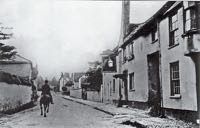
The Admiral Vernon, on the right, in the days of horse. The protuding window on the right may have been used as a lookout for the passing stage coach.
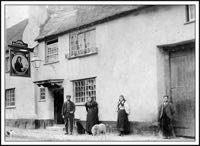
Probably customers and a sheep pose outside the Admiral Vernon in the days of a far more rural Devon.
│ Top of Page │
